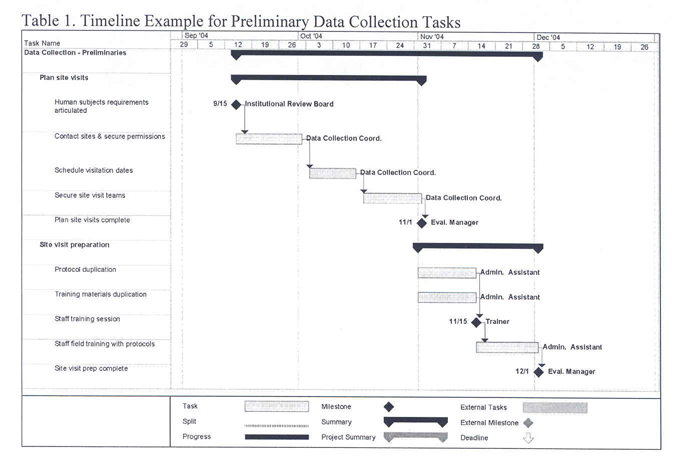 |
||
 |
 |
Key Topics |  |
 |
 |
Strategy |  |
 |
Scenario |  |
 |
Case Study |  |
 |
 |
References |  |
 |
||
Create a data collection schedule that specifies when the data collection tasks and subtasks will be carried out. It should be part of a larger evaluation project schedule. Examples of possible tasks and subtasks on an evaluation project schedule include
Critical to effective scheduling is realism about how much time you will need for recruiting respondents. The greater number of respondents you need, and the more burden you impose on them (see Step 6 for more information on burden), the more difficulty you may encounter in recruiting them. The longer the time period you may need for recruitment and data collection. Additional time will also be required if you need clearances from gatekeepers or institutional review boards (see Step 5 for more information). Scheduling staff time also has its challenges. Be cognizant of that skills your staff will need (e.g., skills in managing and coordinating, doing clerical work, observing, interviewing, contacting gatekeepers and respondents, etc.). Factor into your schedule the amount of training they will need before starting their tasks (see Step 8 for more on training). Then, set realistic expectations about how many hours they will need to complete their tasks. Dates when staff are available to go into the field must match the dates when respondents and data collection sites are available. On evaluation projects that cover large geographical areas and require travel, it is most cost effective to send data collectors to sites that require the least amount of travel. It is also cost effective to schedule them to cover multiple data collection sites in one trip, as long as that does not impose too great a burden on them. Lastly, leave enough time in their schedules for them to complete their field notes in a thorough manner. This time should immediately follow their site vist so their memories of what took place are current and accurate. If your schedule is too tight and they feel rushed, their field notes may suffer because they may move too quickly to the next data collection event without fully taking stock of the prior one. In addition, you will need to schedule sufficient time for your staff to screen the data after entry into a database but before the commencement of data analysis (see Step 9 for more on data screening). Create a timeline for your schedule Once you know the magnitude of the labor and production efforts that your data collection tasks will require, you can get a realistic sense of how much time you will need to accomplish the tasks. A timeline provides a graphical representation. Table 1 shows an example of a timeline for an evaluation project that has been created using a commercially available software program for scheduling (see Step 3 for more on software programs for project management). This particular example shows the schedule for preliminary data collection tasks and subtasks that cover a three-month period. The tasks and subtasks are arranged hierarchically in a column on the left. Each cell in that column represents a different task or subtask. In the example in Table 1, the hierarchy contains three tiers. In the first tier is the overall task, "Data Collection — Preliminaries." As indicated in the second tier, this task encompasses two categories of subtasks: "Plan site visits" and "Site visit preparation." The third tier contains subordinate subtasks. For example, the first subordinate subtask of "Plan site visits" is "Human subjects requirements articulated." The remainder of the table is taken up by the schedule. Lines with down-facing arrows represent time spans that include subtasks. The subtasks are either scheduled as milestones (i.e., single events) or as time spans. Milestones are represented by diamonds and time spans by bars. To the left of the milestones are their scheduled dates. The thin arrows that connect the subtasks represent dependencies, which means that the dependent subtask cannot be carried out until the preceding one is completed. Lastly, the people responsible for the subtasks are indicated to the right of the time span bars.
|
